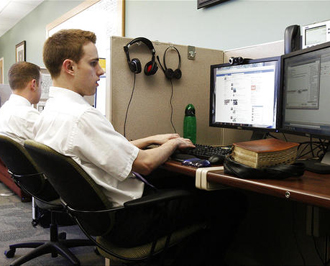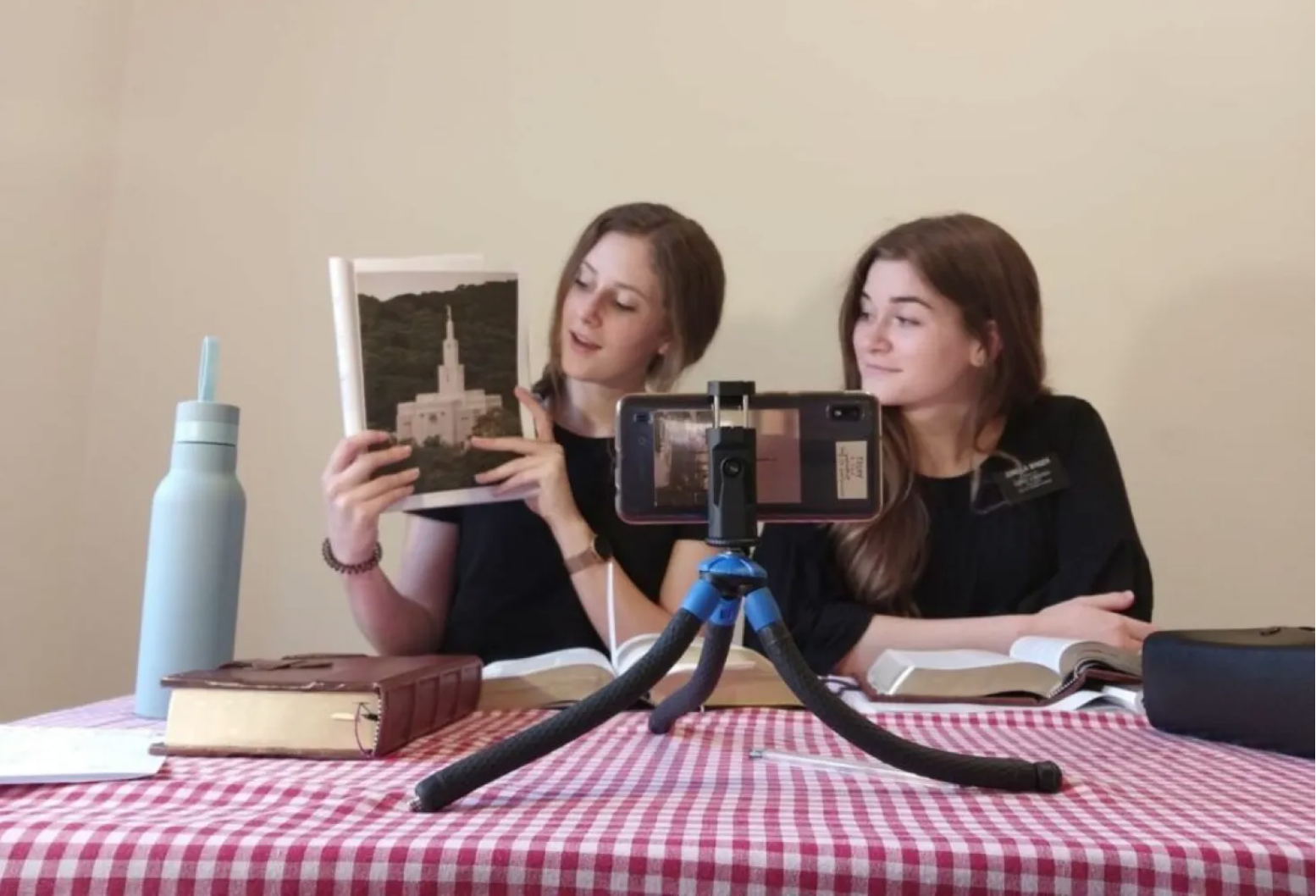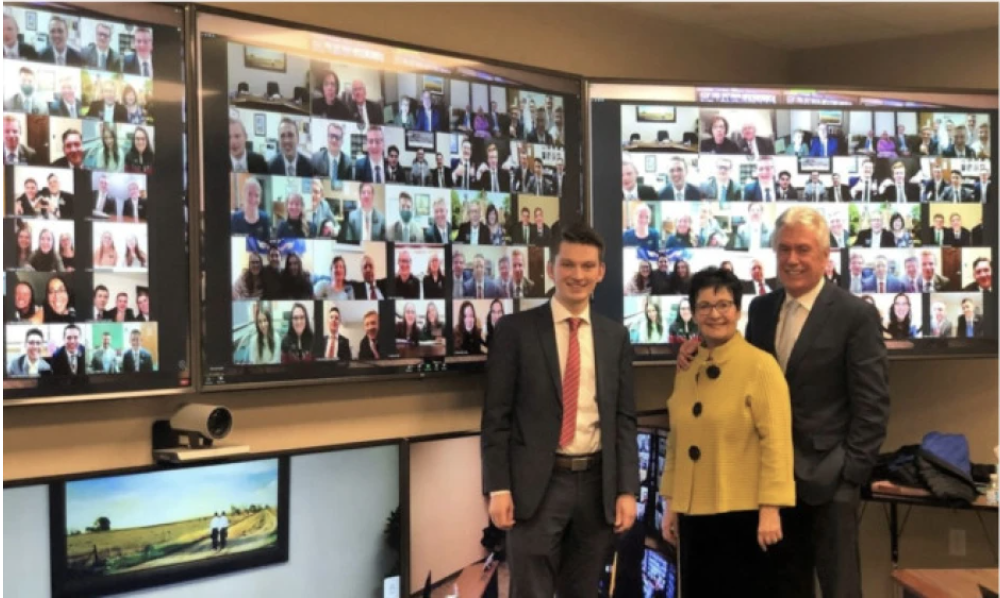Difference between revisions of "Online Mormon Missionaries"
(→COVID-19 Pandemic and an Acceleration of Online Missionary Work) |
|||
| Line 40: | Line 40: | ||
==COVID-19 Pandemic and an Acceleration of Online Missionary Work== | ==COVID-19 Pandemic and an Acceleration of Online Missionary Work== | ||
| − | [[Image:sisters-teaching.png|300px|thumb|right|frame|Sister missionaries serving in the Italy Milan Mission teach an investigator via a smartphone, courtesy of Gail Browning] | + | [[Image:sisters-teaching.png|300px|thumb|right|frame|Sister missionaries serving in the Italy Milan Mission teach an investigator via a smartphone, courtesy of Gail Browning]] |
Most missionaries were sent home to their native countries, then had the option to wait out the pandemic before returning to the country where they were serving. Many missionaries opted to be reassigned to a location in their native countries. | Most missionaries were sent home to their native countries, then had the option to wait out the pandemic before returning to the country where they were serving. Many missionaries opted to be reassigned to a location in their native countries. | ||
Revision as of 16:20, 31 January 2024
By 2011 The Church of Jesus Christ of Latter-day Saints had a small, but growing, program for missionary work online.[1]
Currently, these missionaries work from the Missionary Training Center in Provo, Utah. A handful of missionaries are assigned there full time for the entirety of their missions "to help staff the chat services on comeuntochrist.org. These missionaries teach people all over the world in online chats. From about 2009 through March 2011, these missionaries have helped convert people in 42 states and 20 different countries. Assisting them to help man the chat services 24/7 are Provo MTC instructors, sister missionaries at Salt Lake City's Temple Square, and others in Mexico City and the Philippines.[2]
- The chat starts with a question and often leads to a conversation or exchange, with the online missionaries helping to facilitate needs or answer inquiries — whether the person is looking for a Book of Mormon or other church materials, trying to find a nearby meetinghouse or wanting to make contact with the local missionaries.
- "We try to transition them from curiosity to wanting to learn in a medium that's comfortable for them," said Elder Bryan Sabin of Poway, California. . . .
- The optimum is to have a pair of missionaries — a companionship — engaged together in the same chat. . . .
- Online missionaries work differently depending on the circumstances or the individuals they chat with — they may give some directions or information, engage in lengthy online conversations during which principles and doctrine are taught, or even set up an online appointment for a follow-up chat.
- "We try to get them to the local missionaries and make sure the local missionaries are the primary teachers," Elder Sabin said. "But we don't end our contact, even when we step back from teaching. . . ."
- But sometimes local missionaries are not an option. "We've taught people where there are no missionaries nearby or if they're in countries where there are no missionaries present," said Elder Joshua Albright of Lakewood, Washington.[3]
Many of those who decide to chat from the comeuntochrist.org website are young adults. Missionaries obtain parental permission before continuing with those under the age of 18. Sometimes someone who started with the online missionaries and is being taught by the local missionaries, goes back to the website chat to re-engage — either to ask questions they were too embarrassed or shy to ask of the local missionaries or to confirm elements of what they were taught.
The dangers of online chat are that anonymity comes with the territory. People feel they can log in to spam, or to insult the missionaries or the Church. "Some people come in to prank us, some come in to argue," said Elder Sabin. "But the people who are sincere really stand out."[4]
With the increased — and successful — use of digital devices, technology and online proselyting, the days of full-time missionaries of The Church of Jesus Christ of Latter-day Saints spending their time knocking on door after door to find interested individuals to teach may have gone the way of the flip chart and the flannel board.
A Move to Digital Missionary Work Beyond the MTC
Starting his service as a General Authority Seventy in Missionary Department leadership in 2014, Elder Brent H. Nielson remembers when President Russell M. Nelson — then of the Quorum of the Twelve Apostles — chaired the Missionary Executive Council, assisted by Elder David A. Bednar, also of the Twelve.
That year, then-Elder Nelson introduced the concept of missionaries using mobile devices, now smartphones, in their daily missionary work. At that same time, Elder Bednar gave a talk at BYU Education Week and shared with the Church the blessing that social media could be if used appropriately.
Starting with 20 of the approximately then-400 missions, the Missionary Department tried to figure out how to do missionary work using mobile devices and social media. By 2015 they expanded to 80 missions.
“We continued to learn and to grow and to figure out ways that our missionaries could find, teach and baptize using the internet while also becoming masters of technology. Within a few years we were up to 160 missions, and we stayed with those missions for two or three years, learning and growing and determining the best way for missionaries to find people and to teach them using these devices, while remaining spiritually safe from the influence of the world,” Elder Nielson recalled.
- In January 2020, under the direction of President Nelson, then the President of the Church, approval was given for every missionary in the Church to have access to a smartphone.
- “Think about January of 2020, but most important of all, think about what happened in March of 2020,” Elder Nielson said. “On March 11, 2020, almost every country in the world closed its borders, closed its airports, and international flights were canceled. People were either encouraged or mandated to stay in their homes, and almost all of our missionaries worldwide were unable to leave their apartments. There were many questions proposed to us in the Missionary Department about how we would continue to do missionary work, but I have to tell you that we were ready.
- “Way back in 2014, under the direction of two inspired members of the Quorum of the Twelve Apostles, we had begun the process of figuring out how to do missionary work using these devices. When the world closed down, our missionaries stepped forward and performed a miracle.”[5]
COVID-19 Pandemic and an Acceleration of Online Missionary Work
Most missionaries were sent home to their native countries, then had the option to wait out the pandemic before returning to the country where they were serving. Many missionaries opted to be reassigned to a location in their native countries.
- After hastily bringing home more than 26,000 young people from overseas missions aimed at recruiting new members, the church has begun sending many of them out again in their home countries with a new focus on online work that may persist even after the pandemic, officials told The Associated Press.
- “The leaders of our church have been asking us: What are we learning from this pandemic that will help us become better, become more efficient,” said Brent H. Nielson, executive director of the church’s missionary department. “We’ve learned that finding people, teaching people online is much more effective than trying to meet people in person on a bus or on a street corner or somewhere else. This will change what we do, I think, forever.”
- Nielson said the pandemic has made people hungry for the missionaries’ message of hope. “There’s never been a time when more people have wanted to know about religion than there is now,” Nielson said. “People searching for peace. People searching for answers. People searching for someone to talk to. It’s been an incredible thing.”[6]
The work moved forward. Missionaries using digital technology, such as Facebook, Zoom, videos, WhatsApp, etc. Missionary applications and resulting calls moved to online and missionary training begins online. “Because it wasn’t wise for them to be out on the streets knocking on doors," President M. Russell Ballard said, "they started to knock on people’s computers. They are using technology. They are using ways the Lord has provided. . . .“The Restoration has not stopped. Missionary service has not stopped. The Church hasn’t stopped. We’re moving forward — all in preparation for the Second Coming of the Lord Jesus Christ.”[7]
During October 2020 General Conference, Elder Dieter F. Uchtdorf of the Quorum of the Twelve Apostles said, “At first it may have seemed that a worldwide pandemic would be a roadblock to the Lord’s work. For example, traditional methods of sharing the gospel have not been possible. However, the pandemic is revealing new and more creative ways of reaching out to the honest in heart. The work of gathering Israel is increasing in power and enthusiasm. Hundreds and thousands of stories attest to this. . . .
- In Latvia, a woman who had discovered the Church by clicking on an internet ad was so excited to learn about the gospel of Jesus Christ that she showed up to her appointment an hour early, and before the missionaries ended the first lesson, she asked for a date to be baptized.
- In Eastern Europe, one woman who received a call from the missionaries exclaimed, “Sisters, why haven’t you called earlier? I’ve been waiting!”
- Many of our missionaries are busier than ever. Many are teaching more people than ever. There is an increased connection between members and missionaries.
- In the past, we might have been so tied to traditional approaches that it took a pandemic to open our eyes. . . . Of necessity, we are now learning how to use a variety of methods, including technology, to invite people—in normal and natural ways—to come and see, come and help, and come and belong.[8]
In February 2021, Elder Uchtdorf, then executive director of the Church’s Missionary Executive Council, sat down with his wife, Sister Harriet Uchtdorf, for the taping of a missionary devotional on technology in missionary work.
The setting and medium couldn’t have been more appropriate for the main topic, with the Uchtdorfs interspersed among video cameras and prompters, display monitors showing video clips of full-time missionaries both asking and answering questions, and other screens displaying collagelike views of missionaries in Utah and Washington joining live via videoconferencing.
All for a devotional to be broadcast to full-time missionaries serving worldwide.
External Sources
- Church News Podcast, "Episode 75: Elder Brent H. Nielson on the expansion of missionary work in a digital age," by Sarah Jane Weaver
- [https://www.thechurchnews.com/2022/4/1/23217265/missionary-work-look-back-digital-and-online-developments-in-church Church News, "A look back on the digital and online developments in the Church’s missionary work
," by Scott Taylor]


